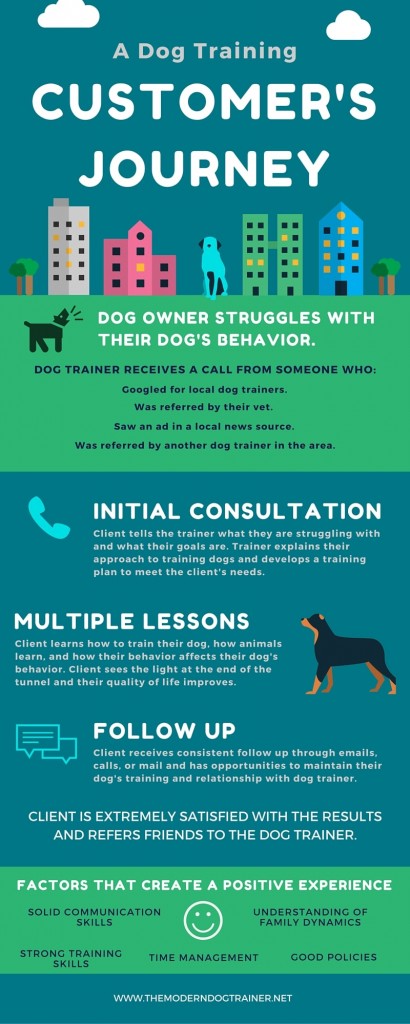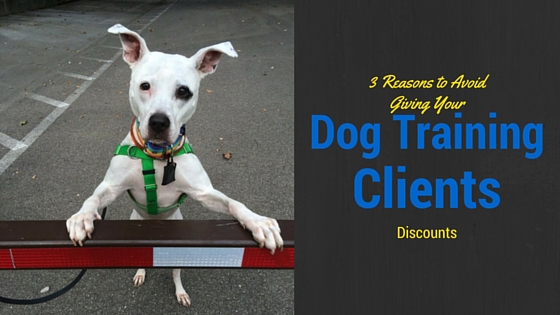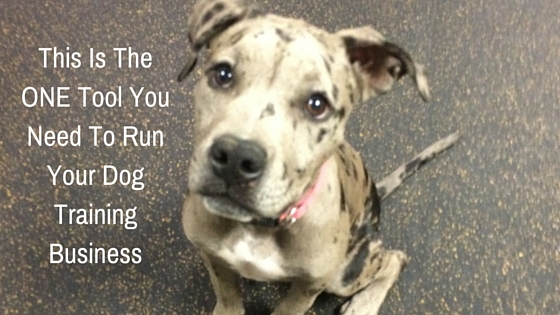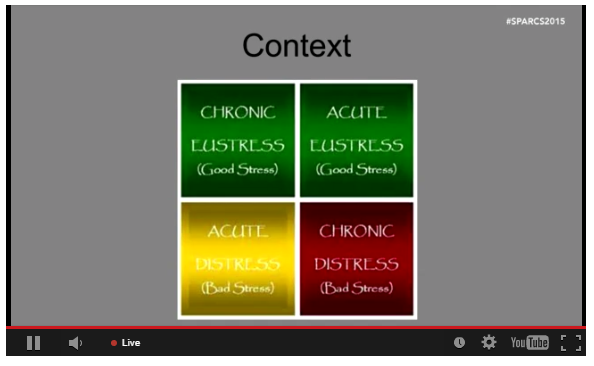![The Modern Dog Trainer Podcast – Ep. 1 Going Full-time]()
by Ines | Oct 31, 2015 | Podcast
The Modern Dog Trainer blog contributors invite the Certification Council of Professional Dog Trainers President, Brad Phifer, to discuss how to prepare yourself to become a full-time dog trainer. See the CPDT’s accompanying article on going full-time as you listen to the podcast!
Subscribe to The Modern Dog Trainer Podcast on SoundCloud or iTunes. Follow The Modern Dog Trainer Blog on Twitter at @ModernTrainer, on Facebook at The Modern Dog Trainer Blog Page, and on Instagram at @TheModernDogTrainerBlog.
The Modern Dog Trainer Podcast – Episode 1 Podcast Show Notes
 Guest Bios:
Guest Bios:
Links mentioned in the show:
Education
Marketing
Referral Gifts
Certifications
Humane Hierarchy
Dog Training Business Tips
Receive valuable dog training business tips and resources right in your inbox! Subscribe to The Modern Dog Trainer now by submitting your name and email below. Don’t forget to let us know what you want to learn more about!
[mc4wp_form]
![The Modern Dog Trainer Podcast – Ep. 1 Going Full-time]()
by Ines | Oct 10, 2015 | Business, Communication
When a prospective client calls you, it is unlikely that they know exactly what to expect. Usually, all they know is that they are in over their heads and they need professional help. Here we discuss the process a successful dog training guides their client through to create a satisfying customer journey.

Acquiring a Dog Training Client
Clients usually get your contact information through four main sources.
- Search Google for local dog trainers
- Their vet refers them to you after you’ve created a strong relationship with the vet.
- Advertising you have paid for in local news sources.
- Another trainer refers them to you if they are unqualified or don’t have time.
Initial Dog Training Consult
The client then goes through an initial consultation either on the phone or in person. This is where you gather as much information about their case as you can. During this consultation, you can develop a training plan that will suite the needs of the dog as well as the family’s situation. This takes a deep understanding of animal behavior training and setting realistic goals for this particular dog and family. Each family will require different environmental setups and each dog will learn in their own way. The more families you work with, the more you will expand your tools in your toolbox.
Several Lessons to Follow-Up
Several lessons are usually needed to make progress in any case. Rarely will one lesson solve an issue. Several lessons allow you to address other issues that may pop up and will allow you to make sure clients are implementing training techniques correctly. Client’s quality of life should improve quickly and they should start to see the “light at the end of the tunnel.”
Follow-Up After Dog Training Lessons
Most new trainers fail when it comes to this part of the client’s journey. (It is something I have done in the past due to lack of experience and understanding.) It is easy to complete lessons and then never initiate conversations with the client again once their problems are “fixed.” However, this is a huge missed opportunity! Maintaining a relationship with the client means you can offer them more services (and continue your income). They will maintain their dog’s training better in the long run. And, ultimately, you’ll stay fresh in their mind so when their friends complain about their dog’s behavior, they can quickly recommend you!
Many factors play a role in satisfying clients. Dog training is a challenging service because much of what contributes to the success of the dog’s training is out of your hands. You can make recommendations, but there is no way to quickly “fix” the dog without complete cooperation from the owner. Even then, many other factors contribute that are out of your control – genetics, history, environment, etc.
Factors that you CAN control include:
- Good communication & social skills
- Strong training skills/knowledge
- Understanding of family dynamics
- Good policies, time management, upholding your promises/appointments
- Follow up with client after lessons are complete
- Provide additional services for maintaining training for dog & relationship with owner
Being a successful dog trainer means being an ever-learning business owner so you can provide the ultimate experience for your customers. In the end, the most successful businesses have a lot of word of mouth referrals. What part of the dog training client’s journey do you need to improve? Share your thoughts in the comments below!
Get Dog Training Business Tips!
Receive valuable dog training business tips and resources every week! Subscribe to The Modern Dog Trainer now by submitting your name and email below.
[mc4wp_form]
![The Modern Dog Trainer Podcast – Ep. 1 Going Full-time]()
by Ines | Sep 28, 2015 | Training Methods
Time is money – all dog trainers know that.
In the old days, for trainers to get paid, clients would have to lug around cash or checks to a training session. That required your clients to have to remember to withdraw cash, or bring their check book. And often times they would forget, forcing you to pester them continually until they get around to writing said check and putting it in the mail. That all lead to extra work on your client’s end, and then leaving you with further trips to the bank to deposit your hard earned dollars.

Electronic invoicing and payments have surfaced to slightly improve this laborious process. This puts less strain on clients (i.e., more time to pay) while giving them payment flexibility (i.e., pay with e-payment, not check). However this requires dog trainers to sit in front of a computer after a long day’s work and send out invoices, which doesn’t even guarantee that payments will be made on time (or at all).
PocketSuite – The Best Dog Training Business Mobile Payment App
Technology has evolved once again! Tools like Square and Venmo allow dog professionals to accept payments and credit cards from their phones while offering convenience to their clients. More advanced apps, like PocketSuite, even allow clients to reserve sessions and appointments upfront with credit card, enabling trainers to process payments while walking out of each session without hassling the client one bit.
Mobile payment apps as a whole offer core benefits compared to what you might be stuck using today, which in turn will help you run a more successful pet professional business.
Fast
Do work, get paid. That’s how mobile payment apps drive business – disrupting traditional invoicing so there’s no cumbersome process or ongoing game of “chase-and-remind” for clients who are late on payment. QuickBooks’ reign of clunky/desktop invoicing is over. Mobile and instantaneous payment methods free up dog trainers to put their time where it counts – on their actual skillset. With extra time on your hands, you are free to complete more sessions and win more clients.
Affordable
Typically, dog trainers who wanted to accept credit and debit card payments had to invest in a merchant processor account. These accounts come riddled with extra fees (e.g., gateway fees, monthly minimum fees, statement fees) totaling between $25 to $35 per month. But now mobile payment options give you the ability to process credit card transactions without the infrastructure of a merchant processor account. Such mobile payment options free you from long-term contracts and numerous hidden fees, offering clear pricing and fast deposits for a fraction of the cost. And the best ones come without any hardware at all.
Convenient
That’s convenience for both you and your clients. While you’re enjoying a life without invoicing and waiting for payments, your clients will enjoy a life with a lot less check writing, cash withdrawing and wallet opening. It’s freedom for both parties. At the same time, mobile payment apps can protect trainers from canceled jobs and client no-shows, by securing customer credit cards upfront when reserving appointments, all the while delivering clients an “Uber-like” experience.
Mobile payment apps flat out just make life easier for today’s pet professional. Dog trainers in particular will find that this independence, flexibility and support that these apps give them when running a business, will yield them more time and money – to help drive their business towards success.
Click the following link ON YOUR MOBILE device to sign up for this signature edition.
https://pocketsuite.io/register/modern-dog-trainer
![The Modern Dog Trainer Podcast – Ep. 1 Going Full-time]()
by Ines | Sep 21, 2015 | Events

The Pet Professional Guild’s (PPG) inaugural educational convention is taking place in Tampa, Florida on November 11-13, 2015. Professional dog trainers with a strong conviction in their belief in force-free dog training will gather to learn about science-based training.
The PPG hopes to build greater awareness about the organization and increase collaboration between colleagues. Savvy pet owners are also encouraged to attend to learn about animal training methods that build communication between owner and animal. Veterinarians who attend will have networking opportunities and learn about force-free animal handling techniques.
The PPG has stood as one of the only organizations that strongly reject the notion of using force in any way to control and train animals. They widely advertise the fall out that shock, choke, fear-inducing, and force-full methods can create. As advocates for training methods, they encourage the use of techniques that motivate animals using positive reinforcement without any use of intimidation.
The Worlds Very First Force-Free Summit
The PPG’s Force-Free Summit is the very first of its kind. Aside from the fact that all content will cover force-free and science-based animal training methods, the Summit will include a variety of educational and entertaining events for all members of the dog and pet industry.
“We can guarantee that our first-ever Force-Free Summit will be a milestone as far as advocating for force-free, positive training techniques is concerned,” said Niki Tudge, PPG president. “We can also guarantee a highly interactive and fun format for all who attend. We have placed a huge emphasis on formulating an educational event that offers a combination of lectures and working LABS, where industry professionals will have the opportunity to work with their pets under the guidance of a highly skilled mentor.”
The PPG Summit will feature more than 26 presenters over its three-day duration, and promises an enticing line-up of speakers and subject matter. World-renowned vet, applied animal behaviorist and author, Dr. Karen Overall, will deliver the keynote address, an unmissable presentation that will cover topics such as the canine brain, the neurobiology of reactivity and stress, assessing behavior and redefining humane behavioral care.

Other speakers at Summit 2015 include a who’s who of behavior and training professionals:
- Dr. Michelle Duda,
- Dr. Soraya Juarbe-Diaz,
- Chirag Patel,
- Ken McCort,
- Jacqueline Munera,
- Pamela Johnson,
- Theresa McKeon,
- Emily Larlham,
- Pat Miller,
- Nancy Tucker
- Laurie Schlossnagle (Our very own Modern Dog Trainer Blog contributor!!!)
- and many more, all of whom will contribute with lectures, working LABS, or smaller, more intimate, interactive sessions
This conference is sure to make some waves throughout the dog training industry. We look forward to hearing from Laurie about her experience as a presenter and attendee. She’ll be posting updates on The Modern Dog Trainer blog about the lectures, networking events, and accommodations so stay tuned!
Registrations for Summit 2015 are still open, with just a few spots left. Various packages are available to ensure delegates have a range of convention experiences and payment options to choose from. Continuing education units are available for PPAB, IAABC, CCPDT, KPA and PPG. For more information, see Force-free-Summit.
PPG Summit Updates
Laurie attended the PPG Summit as a speaker and as an attendee. Read about her experiences in these posts:
Get Dog Training Business Tips!
Receive valuable dog training business tips and resources every week! Subscribe to The Modern Dog Trainer now by submitting your name and email below.
[mc4wp_form]
![The Modern Dog Trainer Podcast – Ep. 1 Going Full-time]()
by Ines | Aug 15, 2015 | Communication

Ethics in the dog training industry is a major area of conflict. Ethics surrounds a variety of topics including relationships between trainers, professionalism, client relations, and, of course, training methods. In this article, some of the professional dog trainers and writers of The Modern Dog Trainer blog discuss their opinions regarding relationships and conflicts between other professional dog trainers. Take a look at what we had to say!
Dog Trainer Ethics – Colleague Relations
#1 – Competition is steep in dog training. Anyone can become a self-proclaimed dog trainer which has its benefits and its downfalls. How would you approach a new trainer entering your service area? How would you gauge their competence?
Kat: Since 95% of dogs receive no training at all, the competition isn’t other trainers, it’s the dog owner who sits on the sofa and does nothing. The only reason to gauge their competence would be to send referrals when I’m busy. If I’m vetting a trainer for that purpose there are usually tacos and margaritas involved.
Liz: I’m not a full-time trainer, so maybe #1 doesn’t affect me as much as others. But I’m thrilled when I can offer other resources to people whose schedules don’t mesh with mine, or if their dog’s issues are outside my knowledge base. I use word of mouth and FB page/website reviews to begin my gauging of their competence.
Lisa: I would introduce myself to them and let them know that I have been training for many years and would love to be able to refer clients to them if I could not fit them in. During the convo, I would ask questions as to how they became a trainer, their experience, how many dogs they have trained, what methods they use, what books they’ve read, what courses they’ve taken, who they apprenticed under, etc.
#2 – What are some benefits to welcoming the new trainer with open arms? What are some downfalls to being so open and friendly to them?
Liz: I generally don’t see downfalls, again maybe because I’m a part-timer. Huge positive to being welcoming though, as I said above, is another person to refer cases to.
Lisa:
- Benefits – someone who may refer you to clients they cannot deal with, someone you can talk to, share ideas and help each other out.
- Downfalls – They use your info and go behind your back to contact your clients, bad talk you, undercut you in prices.
#3 – Lets say that there is a trainer in your area that is less than positive with the dogs, but he has a great reputation with the community. How do you educate your clients about the differences between you and the competitor without turning them off?
Kat: The only reason to discuss another trainer is if an existing client used that trainer previously. This is fairly common for behavior modification cases. There generally isn’t enough time to discuss other trainers, either good or bad. Just discuss the training techniques that failed and why they need to be changed.
Erin: I find it more professional to not so much address the trainer as much as methods used. Discuss how the methods can be disadvantageous to the training using science and examples. This way the client is provided with information to make a sound decision.
Monica: I generally explain how I train and include things I don’t train with. I’m very open with how I train and let them know I use no fear or intimidation. I just kindly tell them that their training methods and my training methods differ greatly.
Liz: I leave it with, “their methods are very different from mine,” and then I explain my methods.
Lisa: The key is to never criticize the competition. Simply explain the positive methods that I use, letting them know that studies and research has been done to show it is more effective than using aversives. Quote the AVSAB Position Statements and use examples of their work environment or kids in learning in school. I find it’s very helpful to use examples that they can personally relate to.
#4 – Many times, online and offline, even positive trainers have their disagreements. How do you agree to disagree politely? (Feel free to give an example.)
Monica: Just tell them, I don’t agree with that statement but it is ok. We have come to different conclusions through our studies of dog training. If they continue to heckle you about your choices, then it’s time to leave the discussion.
Liz: I explain my side and leave it at that. Arguing won’t change minds. I prefer to change minds by using my training as an example, as opposed to lambasting people. Positive training works on people, too.
Lisa: I would let them know that we don’t have to agree. Everyone is entitled to their opinions and, just like how they gave their opinion, I have given my opinion.
#5 – Dog training is a very emotional industry. What would be an appropriate response when you discover someone is bad mouthing you within your service area?
Kat: Ignore it, unless it takes the form of fake reviews and infiltration of your social media accounts, in which case seek legal counsel.
Liz: Again, I won’t argue back or badmouth back. I take the higher road and let it go. I let my training speak for itself.
Lisa: I would need to find out what they were bad mouthing me about, and try to explain the situation to them. If they persist, then I would send a lawyer supported letter to see if I could get them to cease and desist. Or it just might not be worth the hassle, so I just ignore them completely.
Join in the conversation! What would you do in these situations? Leave your response in the comments below.
Get Dog Training Business Tips!
Receive valuable dog training business tips and resources every week! Subscribe to The Modern Dog Trainer now by submitting your name and email below.
[mc4wp_form]
![The Modern Dog Trainer Podcast – Ep. 1 Going Full-time]()
by Ines | Aug 10, 2015 | Business

As small business owners, we’re always looking to acquire new dog training clients. Discounts are a popular option that we think you’d better avoid.
1. Dog Training Clients Who Compare Prices Are Not The Right Clients For You
In reality, clients who are looking for the cheapest trainer in town are not looking for the most qualified and skilled dog trainer. You’re better off focusing your energy trying to get clients who will value your time and qualifications. If you’re looking to give back to the community, limit your free or discounted lessons to one or two lessons a week for those in need, but don’t make it the norm for all your clients. Consider creating a scholarship program for those that need your help, but cannot afford it immediately. This will weed out people who are just looking for a quick bargain and you’ll find some truly dedicated clients who simply can’t afford your usual price.
2. It Is Very Hard To Wean Customers Off Discounts
Once they’ve had a taste of your services at a discount, it can be difficult for clients to adjust to higher prices. They may continue to ask for discounts for one reason or another. This conflict could drain your energy and it may damage the relationship between you two.
3. Cutting Your Own Profit Margins
When we give discounts as dog trainers and small business owners, we’re emptying our own pockets. Discounts cut the profit margins and they devalue the product or service a client purchases. Unfortunately, the client is less likely to follow through with training plans and are less likely to sign up for full-priced services in the future.
Fortunately, there are hundreds of alternative ways to attract new clients.
The Best Alternative To Discounts
There is a simple alternative to offering discounts for your services. Consider providing add-ons for “free” so that the client perceives that they are getting a better deal by getting additional products or services. This way you can maintain your desired income and they are getting a great deal. It’s a win-win for both sides of the client-trainer relationship.
What are some ways you attract new clients? Leave your ideas in the comments below!
Get Dog Training Business Tips!
Receive valuable dog training business tips and resources every week! Subscribe to The Modern Dog Trainer now by submitting your name and email below.
[mc4wp_form]
![The Modern Dog Trainer Podcast – Ep. 1 Going Full-time]()
by Ines | Aug 6, 2015 | Training Methods

The majority of dog trainers run their business out of their car. They are always on the road going from home to home. We use a variety of tools to track our clients’ progress, send invoices, and schedule lessons or day training. Some of those tools include notebooks, iPhones, tablets, laptops, and desktop computers. Switching between this many devices can be a recipe for disorganization, missed appointments, and worst of all – the client’s dog not making as much progress as they should.
Fortunately, there is a new app available for FREE to dog trainers. PocketSuite is an iPhone app that allows a dog trainer (or other pet business) to run their business right out of the palm of their hand. This iPhone app is designed for solopreneurs and mobile professionals just like dog trainers. It allows you to send quotes, schedule appointments, track revenue, message clients, and get paid right in one location on your iPhone.
Click the following link ON YOUR MOBILE device to sign up for this signature edition.
https://pocketsuite.io/register/modern-dog-trainer
1) Schedule a Lesson and Never Think About It Again
 With Pocketsuite, you can schedule a lesson or package of lessons with a client and rest assured they will receive a reminder notification at a set time before their lesson(s). Never worry about forgetting their lesson, forgetting to send a reminder, or purchasing a separate reminder service for your business.
With Pocketsuite, you can schedule a lesson or package of lessons with a client and rest assured they will receive a reminder notification at a set time before their lesson(s). Never worry about forgetting their lesson, forgetting to send a reminder, or purchasing a separate reminder service for your business.
Worry about client’s keeping their commitments? This app allows you to ask for confirmation with the client’s credit card. If they cancel last-minute, you can charge an automatic cancellation fee for the inconvenience.
2) Send Invoices With An Auto-Reminder
Group all your client’s purchases in a single invoice that you can send via text or email. Then, if they don’t pay immediately, the app will send automatic reminders every day, every three days, or once a week depending on your preference. You won’t have to remember to remind your clients and it will be more likely that you’ll get paid on time!
3) Pay A Smaller Credit Card Processing Fee Than Any Other Service
That’s right! PocketSuite only charges 1.99% per charge as compared to PayPal (2.9%), SquareUp (2.75%), or Stripe (2.9% + 30¢). The app allows you to track your previous and predicted income easily. Clients can pay safely with their credit card or Apple Pay. With the app, you will never see their credit card information which will make clients feel more secure about purchasing services from you.
4) Integrate PocketSuite With Your Website & Accept Appointment Reservations
 PocketSuite integrates very simply with any website. Through the app, sign up for the widget and it will send you instructions on how to set up online registrations on your website. You can adjust your availability within the app – on the go – and it will seamlessly update with your online widget to prevent double booking.
PocketSuite integrates very simply with any website. Through the app, sign up for the widget and it will send you instructions on how to set up online registrations on your website. You can adjust your availability within the app – on the go – and it will seamlessly update with your online widget to prevent double booking.
Click the following link ON YOUR MOBILE device to sign up for this signature edition.
https://pocketsuite.io/register/modern-dog-trainer
![The Modern Dog Trainer Podcast – Ep. 1 Going Full-time]()
by Ines | Aug 4, 2015 | Training Methods

Clickers are absolutely wonderful to help dogs and their owners communicate effectively and quickly. They make the dog’s learning process easier, but they can make things a bit more complicated for their owners.
Presenting the Clicker Ring
Josh Pitts, the founder and creator of Clicker Plus, has designed a revolutionary new clicker that will make clicker training less of a juggling act for the average dog owner. The Clicker Ring is a ring with a mechanical clicker built into it. This innovative tool will make clicker training easier and more fun for everyone!
1) Anyone Can Clicker Train With The Clicker Ring
The benefit to turning the clicker into a ring is that it will allow dog owners with disabilities or movement restrictions to train their dog. They no longer have to worry about dropping the clicker if they accidentally open their hand which will improve their timing – which is so important during training!
2) Everyone Will Be Able to Wear One
The Clicker Ring comes in a variety of sizes which means people short and tall, large and small will be able to wear them. It is discrete so even self-conscious client’s will be able to use a clicker to train their dogs.

3) Fast & Easy Access To A Clicker
How many times have you told a client to keep the clicker ready during classes or when working with reactive dogs? Now they will have no choice but to have the clicker available to them at all times. This will keep them from fumbling around to find their clicker when they need it most – usually when they least expect it!
4) Less Juggling, More Clicking
Between the leash, treats, listening to instructions, and a dog pulling on the other end of the leash, dog owners can quickly get overwhelmed during classes or private lessons. They are learning a lot of new information in a very short time frame. The clicker ring takes away a small, but challenging variable to their, and their dog’s, learning process by making it more convenient to use during training.
Learn more about the clicker ring and pre-order yours today!

Get Dog Training Business Tips!
Receive valuable dog training business tips and resources every week! Subscribe to The Modern Dog Trainer now by submitting your name and email below.
[mc4wp_form]
by Ines | Jun 21, 2015 | Events, SPARCS
Best Emerging Researcher
“Developing a Practical Means of Reducing Stress in Animal Shelter Dogs” with Regina Willen
The first three days a dog lives in a shelter the cortisol levels are highly elevated. Human interaction can be used to reduce stress in this environment.
Petting had a calming effect on the dogs. There was a significant reduction in cortisol, vocalization, anxiety/panting, and escape attemps.
Petting for 30 minutes was just as effective as 15 minutes, but results lasted longer with 30 minutes of petting. Cortisol reduction is transient.
Owner relinquished dogs had higher levels of stress in the shelter than stray dogs.
News release about her findings: http://webapp2.wright.edu/web1/newsroom/2015/04/16/puppy-love
![The Modern Dog Trainer Podcast – Ep. 1 Going Full-time]()
by Ines | Jun 21, 2015 | Events, SPARCS

Positives of Dog-Human Relationship
Dogs provide non-judgemental respite in a complex world. Examples of beneficial dog-human relationships:
- Autistic children – helps with socialization.
- Military veterans
- Students facing exams
- Busy professionals – bring your dog to work.
The Other Side of the Dog-Human Relationship
- Dog Bites – Children bitten by dogs. Usually family dogs. Good dog has been great with the family for a long time. Big event/celebration. Stressed dog reacts unusually to known child due to trigger stacking.
- Behavior Issues
- Household destruction – does not reduce the person’s stress.
- Compulsive behaviors associated with stress
Products that help reduce stress are endless. Some products may actually contribute to some stress.
What is Stress?
Stress is an inferred internal state. Stress denotes a real or perceived perturbation from physiological homeostasis and psychological well-being.
- Distress is when the animal cannot cope with the stress.
- HPA axis & Fight/Flight Response – Adrenaline is short-term response. Cortisol is longer term response.
Arousal and Context

Arousal is neutral. Context (cognitive interpretation) and arousal determine the emotional response.

Context
- Chronic Eustress (Ex: Good housing)
- Acute Eustress (Ex: Playtime)
- Acute Distress (Ex: Sudden injury)
- Chronic Distress (Ex: Poor housing – old shelter design)
Arousal & Behavioral Performance
Low arousal leads to low performance. Some arousal is necessary to success. However, once arousal becomes too great, distress sets in, and performance declines. Higher skill leads to higher tolerance of stress and a better ability to perform well under higher levels of stress.
Treatments for Stress
Common stressors:
- Foreign people/dogs
- Fireworks
- Injuries
- Impoverished environment
Common Treatment:
- Desensitization
- Counterconditioning
- Operant conditioning
- Medications

Treatment Ideas
- Work on arousal and cognitive interpretation separately.
- How does breed effect arousal?
- Do beagles respond more strongly to smells?
- Do guard dogs respond more strongly to strangers?
- Modern dogs are not using the skills they were bred for anymore.
Future Dogs
- Better understand dog’s mind.
- Better understand bonding with people and dogs.
- Better breeding for companionship.
- Better roles for dogs – working dogs – search and rescue, drug detection, etc.
Take Home
How can we provide opportunities for Eustress?
- Puzzle toys that are too hard can cause distress.
- Cats can get distressed with laser pointers because the cat cannot ever “catch” the laser. Make the laser pointer lead to the treat so that there is an end to the chase.
- Provide pathways for the animal to find fulfilment.
 Guest Bios:
Guest Bios:








 PocketSuite integrates very simply with any website. Through the app, sign up for the widget and it will send you instructions on how to set up online registrations on your website. You can adjust your availability within the app – on the go – and it will seamlessly update with your online widget to prevent double booking.
PocketSuite integrates very simply with any website. Through the app, sign up for the widget and it will send you instructions on how to set up online registrations on your website. You can adjust your availability within the app – on the go – and it will seamlessly update with your online widget to prevent double booking.








